Cholula Hot Sauce At The National Restaurant Association, Chicago
For three generations, Cholula has been produced in Chapala, in the state of Jalisco, Mexico, This small sun-baked outpost is a one hour ride from Guadalajara and it is here that tequila was born and where a small family began making their unique hot sauce.
Jarritos
Started in 1950, Jarritos is the first national soft drink brand in Mexico. It is the leading brand in the mexican soft drink category in the U.S and a mexican cultural icon. Jarritos is available in eleven delicious fruit flavors: Tamarind, Mandarin, Fruit Punch, Jamaica, Lime, Grapefruit, Guava, Pineapple, Strawberry, Mango and Watermelon.
Jarritos History
Over 50 years ago, Don Francisco El Güero Hill had the vision to create a line of soft drinks made from natural fruit extracts that would reflect the flavors and popular taste of the Mexican people. He worked on the development of flavors for his soft drink product that would later be known as Jarritos. The brand name finds its origin in the Mexican tradition of drinking coffee, water and other drinks in clay pottery jugs, called jarritos, because it keeps beverages fresher and cooler.
The Jarritos Chronology
A Leader is Born
1950 With a unique bottle design of 400ml, when in Mexico the industry standard was 350ml, Jarritos launches its Coffee flavor in Mexico City , becoming the first national brand of Mexican soft drinks in the country.
1951 The following year, El Güero Hill develops a process that allows tamarind juice extract to be suitable for a soft drink, resulting in the first tamarind flavored soft drink in Mexico and enjoying of great market acceptance.
1951 Throughout the same year develops Mandarin, Lemon and Fruit Punch flavors, gaining a bigger market share.
1954 In less than five years after its conception, Jarritos is the best-selling Mexican soft drink and enjoys trade
1955 distribution in central Mexico second only to Coca-Cola.
1960 Jarritos is distributed and/or bottled in 80 percent of the states of Mexico.
True Fruit Makes the Difference
1960 As the brand keeps expanding throughout the Mexican republic, it begins acquiring new tastes and flavors according to the regional traditions for Mexican food. Grapefruit, for instance, is made from fresh grapefruits from the state of Veracruz , Jamaica uses extracts from Jamaica flowers of Guerrero and Oaxaca , Lemon is made with lemons from the region of Colima , the same with Pineapple, which is made from the fruits of the state of Tabasco . To this date, each region awaits the harvest season to provide Jarritos with the best fruit year after year.
Crossing the border
1982 With the emigration of Mexicans to the US , the demand of Mexican products in this country became imminent. Truckloads of Mexican products were crossing the borders everyday and Jarritos was almost in all these loads.
Jarritos gets its passport
1988 The Hill family from Mexico City , and the Fernandez family from Ciudad Juarez , saw this need and formed a strategic alliance to begin the exportation of Jarritos to the US.
1989 Jarritos Mandarin and Tamarind in glass bottles imported from Mexico begin selling in a few markets in the U.S.
1991 Jarritos brings other delicious flavors from Mexico Lemon , Jamaica , Grapefruit, Pineapple, Fruit Punch and Guava.
1993 Jarritos introduces a 2 liter size in Mandarin, Tamarind, Fruit Punch and Lemon in the market to cater family needs.
The Leader Strikes Again
1997 Jarritos is available in all major Hispanic markets across the U.S. becoming the leading Mexican soft drink brand in the U.S.
2000 New Strawberry flavor introduced Grapefruit available in 2 liter.
2001 Jarritos pioneers plastic 20 oz size for convenience stores and other points of sale.
2002 Introduction of Strawberry and Pineapple in 2 liter format all 2 liter bottles changed to new authentic bottle shape.
2005 Two delicious new flavors are introduced in the US Hispanic market Mango and Watermelon.
Cholula's Flavorful Fire finds its roots in a well-guarded family recipe that's over 100 years old. This recipe blends pequin peppers, red peppers and spices in a delicate process that produces a perfect balance between flavor and heat. The family chose the name Cholula after the 2,500 year old city in Mexico. Cholula is the oldest inhabited city in Mexico and famous for its 365 churches. The term Cholula is derived from the pre-Hispanic word "Chollollan" meaning "the place of the retreat." It was only a matter of time that Cholula became the favorite hot sauce of locals.
What was started as a small family business soon gained international acclaim. Bottles of the zesty, delicious hot sauce began popping up in restaurant kitchens and retail stores all over North America. It did not take long for chefs and consumers to discover the unique flavor that Cholula brings to every recipe. Cholula's fans are a diverse crowd, ranging from rock stars and professional basketball players to presidents and world renowned chefs.
Cholula's fame has moved beyond its flavor. Over the years, Cholula's intriguing packaging and patented wooden cap has become a quality icon, a status symbol recognized by millions. Cholula developed the wooden cap and custom bottle shape to represent the care and quality tradition of Mexican artisanship. It has even inspired members of the California Carving Guild to hold annual contests where the creative woodworkers carve images into Cholula caps.
Each batch of Cholula is still made with pride by the same family in Jalisco. It is the perfect complement to eggs, soups, meats, salads, drinks like Bloody Mary's, and in sauces or sandwiches and pizza. Cholula's Flavorful Fire captures the essence of "good eating" with its rich heritage, tradition and unique zesty flavor.
Where does the name Cholula come from?
It is named after Cholula, the oldest inhabited city in Central America. It is a 2.500 year old city in Mexico and famous for its 365 churches. The term Cholula is derived from the pre-Hispanic word Chollollan meaning the place of retreat.
What is the difference between Cholula Hot Sauce
and other Hot Sauces?
Flavor! Cholula perfectly balances flavor with just the right amount of heat. Were not trying to blow-up any mosquitoes! Cholulas special blend of red peppers, piquin peppers and spices is a zesty and intriguing complement to all your favorite foods or in your signature recipes. Its an enhancing experience, not a blasting experience!
How hot is Cholula?
Cholula is flavor with a strong character. Capsaicin is the heat substance in a pepper. In 1912, Wilbur Scoville developed a test to measure heat in a pepper. Bell peppers range from 0-100 Scoville units, pure Capsaicin ranks at about 15,000,000. Habenaros, a very hot pepper used by some other hot sauces, ranks between 200,000-300,000 Scoville units. Pequin peppers, used in the delicate yet robust potion that is Cholula, ranks 3,600 Scoville units on the scale.
Where is Cholula Hot Sauce made?
Cholula Hot Sauce is made in Chapala, which is a one hour drive from the city of Guadalajara, a five hour drive from Mexico City, a four hour flight from Los Angeles, 1,000 miles from Dallas, TX and a long way from New York City.
How long has Cholula Hot Sauce been available?
Cholula has been in existence for at least three generations it has been commercially available in the United States for 12 years.
Where can I find Cholula?
At your favorite restaurant, if not, tell them to get it - or just bring your own until they do. Otherwise, try your favorite grocery store. Still cant find it? Click here or visit our store.
Is Cholula Hot Sauce good for my health?
It improves your looks, helps attract the chicks and you will live to be a very old person. All kidding aside, Peppers, along with garlic and onions offer many significant health benefits. Top of the list has to be their healing effect on respiratory problems. Hot peppers have always played an important role in traditional Chinese medicine. They are recognized for their ability to tackle pulmonary and respiratory illnesses. Peppers contain capsaicin which helps the lungs function more effectively. In addition, a daily intake of peppers is highly recommended for smokers and even non-smokers.
The health benefits of a daily intake of peppers are well established. Eating peppers can:
Reduce respiratory illnesses
Help asthmatics breathe more easily
Control and often cure sinus and nasal passage problems
Reduce headaches
Provide a major source of vitamin C
And if thats not enough, capsaicin also appears to increase your metabolic rate so you can burn more calories. This is an important finding for dieters. So pour on the Cholula all over your low fat foods! Youll also benefit from the other perks: lower triglycerides and great digestion.


